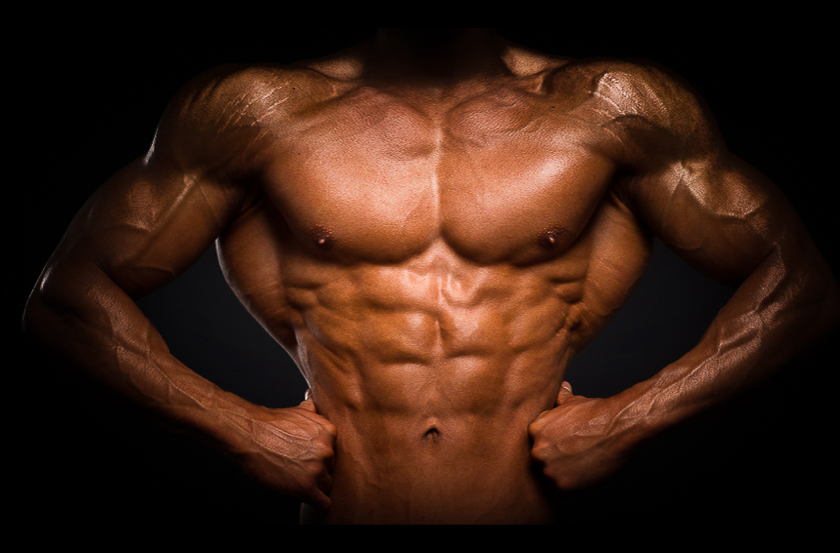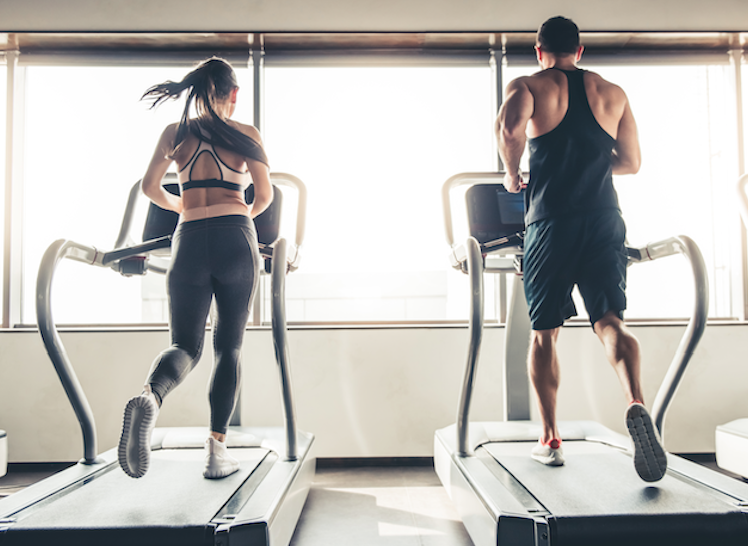LISS vs HIIT - The Ultimate Fat-Loss Showdown

It’s one of the biggest bodybuilding and fitness debates: Which activity should you do in addition to your lifting to get and stay lean—low-intensity steady state (LISS) or high-intensity interval training (HIIT)?
Firstly, just so everyone is on the same page, let’s look at typical examples of both activities: A typical HIIT session would be running on a treadmill at 6 kilometers per hour for 5 minutes to warm up and then cranking the speed up to 16 KPH (or whatever speed represents at least 95 percent effort) for 30 to 60 seconds and then back down to 8 KPH for 2 to 4 minutes, followed by a warm-down and perhaps stretching. Research has shown very dramatic metabolic and fat-burning benefits from doing only 4 such intervals 3 times per week. LISS typically includes walking or jogging slowly for about 4 to 8 KPH for 30 minutes to as much as an hour or more and sometimes twice per day pre-contest.
So now that we know what we’re comparing, before we answer any such question, the first thing we always have to ask is “What are the main goals we're trying to achieve?” In fact, there are four:
1. Lose maximum fat
2. Lose minimum muscle
3. Avoid having to cut calories too greatly
4. Spend minimal time in the gym
Lose Maximum Fat
 For this first and primary goal of burning maximum fat, let’s look at the differences between these two fat-loss exercise approaches. Many still think HIIT sounds too good to be true; they’re skeptical that you can spend so little time and lose so much fat. Many also believe that it’s so intense that it must cause too much additional training stress and accompanying muscle loss. Then there’s the belief that most of the top bodybuilders still use it for contest prep, and some people still even buy into the “fat-burning zone” argument.
For this first and primary goal of burning maximum fat, let’s look at the differences between these two fat-loss exercise approaches. Many still think HIIT sounds too good to be true; they’re skeptical that you can spend so little time and lose so much fat. Many also believe that it’s so intense that it must cause too much additional training stress and accompanying muscle loss. Then there’s the belief that most of the top bodybuilders still use it for contest prep, and some people still even buy into the “fat-burning zone” argument.
Let’s examine these beliefs. Firstly and most obviously, it’s been known for a long time that long, slow cardio doesn’t burn fat as effectively as more intense exercise. The old-fashioned “fat-burning zone,” which is the intensity level of cardio at which you burn the highest “percentage” of fat during exercise isn’t the level of intensity at which you burn the most calories. Many people are also coming around to the fact that after higher intensity exercise, people continue to burn more calories and fat after they finish training and for longer. As will be explained, HIIT takes this concept one step further.
Most important is the fact that HIIT doesn’t just burn slightly more fat than LISS—it burns a huge amount more! As one example (of many) of what can be achieved by HIIT training, scientists at McMaster University used a protocol that included 60 seconds of intense exercise (at 95 percent of VO2 max) followed by 75 seconds of rest, repeated for 8 to 12 cycles. The results demonstrated that from just 3 such sessions (less than 90 minutes) per week, the training effect was comparable to 5 hours a week at 50 to 70 percent of VO2 max!
 Before this study, when another group of Canadian researchers compared HIIT to cardio for fat loss, they found that for every calorie burned during exercise (so theoretically the amount that the calorie calculator on the treadmill displays), the HIIT group actually lost nine times more fat. Most astute MUSCLE INSIDER readers will know that the reason for this is that higher intensity exercise causes a phenomenon called excess post-exercise oxygen consumption (EPOC). In simple terms, EPOC represents the extra calorie burning that the body partakes in to recover and prepare itself for future such activity … and this is where HIIT gets incredibly fascinating!
Before this study, when another group of Canadian researchers compared HIIT to cardio for fat loss, they found that for every calorie burned during exercise (so theoretically the amount that the calorie calculator on the treadmill displays), the HIIT group actually lost nine times more fat. Most astute MUSCLE INSIDER readers will know that the reason for this is that higher intensity exercise causes a phenomenon called excess post-exercise oxygen consumption (EPOC). In simple terms, EPOC represents the extra calorie burning that the body partakes in to recover and prepare itself for future such activity … and this is where HIIT gets incredibly fascinating!
You see, these clever Canadian researchers also took biopsies (actual muscle samples) from the study subjects to see what kind of metabolic magic was happening that caused such substantial differences in body composition changes between LISS and HIIT, and the answer is astonishing! They saw the expected increase in the carbohydrate-metabolizing enzyme phosphofructokinase (PFK)—due to HIIT using primarily glucose for fuel. However, the LISS group didn’t experience the expected increase in levels of a key fat-metabolizing enzyme called 3-hydroxyacyl coA dehydrogenase (HADH), despite the fact that cardio relies predominantly on fat for fuel, but the most surprising thing of all was that levels of HADH did increase substantially in the HIIT group—and other studies have shown that HIIT stimulates a variety of other fat-burning enzymes too. So even though HIIT training doesn’t use much fat for fuel, metabolic fat-burning activity goes through the roof with HIT training?!
So What’s Going On Here?
 Well, as we know, the body uses more and more glucose and less and less fat for fuel as the intensity of exercise approaches its maximum because fat cannot be oxidized without plenty of oxygen available whereas glucose can. This seems to make the case against using HIIT to burn fat, but bear with me. You see, a good HIIT session can burn off the majority of your glycogen, and if you’re watching your excess carb intake and doing HIIT regularly, you won’t be restoring these levels, so the body naturally adapts because our genes haven’t changed much since the days when we had to have available energy to sprint away from a threatening situation in order to survive.
Well, as we know, the body uses more and more glucose and less and less fat for fuel as the intensity of exercise approaches its maximum because fat cannot be oxidized without plenty of oxygen available whereas glucose can. This seems to make the case against using HIIT to burn fat, but bear with me. You see, a good HIIT session can burn off the majority of your glycogen, and if you’re watching your excess carb intake and doing HIIT regularly, you won’t be restoring these levels, so the body naturally adapts because our genes haven’t changed much since the days when we had to have available energy to sprint away from a threatening situation in order to survive.
The way the body adapts in the post-exercise period after HIIT is that it not only reverts back to using pre-exercise ratios of fat and glucose for energy, it now switches to using substantially more fat. This is because the only possible way it can replenish glycogen substantially is by “sparing” (not burning) carbs. And the only way to spare carbs from being oxidized is to burn more fat. This explains the fascinating discovery of higher HADH and other fat-burning enzymes in subjects doing HIIT! The increase wasn’t due to the body adapting to using more fat during exercise (because it doesn’t). It was because the body had increased its use of fat for fuel following exercise in the phenomenon called EPOC! So the mystery of the incredible effectiveness of HIIT has actually been solved and confirmed by other researchers—it’s just that this still hasn’t been conveyed to the fitness and bodybuilding community very well yet!
Sparing Muscle
 I know some of you are probably saying, “Yeah, but am I going to lose more muscle along with all that fat if I switch to HIIT?” The answer is “no.” In fact, the best evidence suggests that HIIT is less catabolic than LISS!
I know some of you are probably saying, “Yeah, but am I going to lose more muscle along with all that fat if I switch to HIIT?” The answer is “no.” In fact, the best evidence suggests that HIIT is less catabolic than LISS!
Let’s look at the facts: As most of us know, combining strength training and intense cardio (and possibly HIIT) impairs the response to both, making you smaller, slower, and weaker. An analysis published in the Journal of Strength & Conditioning Research of over 20 of the best studies on the topic showed that adding significant aerobic exercise to weight training decreases muscle growth by about 30 percent and strength gains by about 15 percent. Most notable for our discussion today is that the study showed that long-duration endurance-training sessions have a substantially more detrimental effect on muscle gains than frequent, short, cardio-type training. However, it should be noted that many of the studies in this review used more intense cardio, so we could use a little more direct comparison studies, but it doesn’t look good for LISS.
In contrast to the LISS results, this review also concluded that when short, intense, sprinting-type exercise sessions were added to weight training, the negative impact on strength and muscular development disappeared completely, so an intelligent HIIT regimen shouldn’t impair muscle growth or performance. Another thing to note is that cycling cardio was less catabolic than other forms, and most HIIT studies were done on stationary bikes.
So What’s The Best HIIT Program?
 HIIT is made up of sessions in which you combine “intervals” of low-intensity cardio with those of virtually maximal activity. This allows you to recover during the slower part of the interval so that you can go that much harder during the intense part. The two biggest mistakes people make with HITT are not resting adequately during the “rest” interval and not going hard enough in the intense interval. There are many ways to try and get this balance right, but the easiest (and I think the best) is to, right after your intense interval, take the pace down to something very relaxed and wait until your breathing is almost normal again before you crush your next intense interval.
HIIT is made up of sessions in which you combine “intervals” of low-intensity cardio with those of virtually maximal activity. This allows you to recover during the slower part of the interval so that you can go that much harder during the intense part. The two biggest mistakes people make with HITT are not resting adequately during the “rest” interval and not going hard enough in the intense interval. There are many ways to try and get this balance right, but the easiest (and I think the best) is to, right after your intense interval, take the pace down to something very relaxed and wait until your breathing is almost normal again before you crush your next intense interval.
As far as getting the intensity right, your intense intervals should be at least a 95 percent effort. (Of course, you need to work up to going this hard, so don’t try and sue me if you tear a hamstring by doing all-out sprints for the first time in 10 years!)
My review of the research (and I’ve read as many studies on this as anyone) is that an interval between 20 and 60 seconds is best, and probably about 30 seconds seems to be ideal. Depending upon your level of conditioning and whether you’re used to the particular type of activity, rest periods should be 2 to 4 minutes (closer to 2 if you’re in shape and used to the activity and closer to 4 if not).
So I would recommend that although LISS can be added to your routine for the last few weeks before a contest, most people should focus on doing three or more high-quality HIIT sessions per week for optimal fat loss and muscle preparation when dieting.

